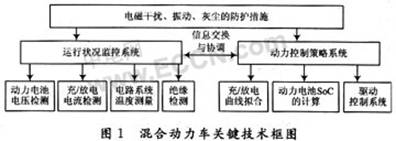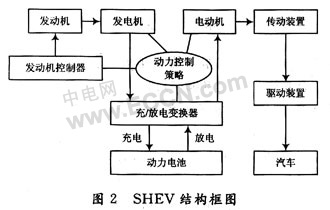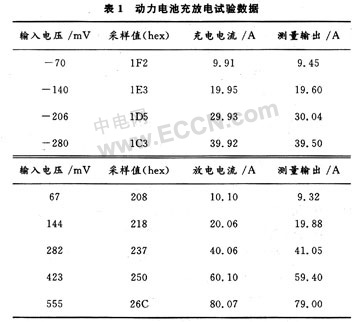The rapid development of the automotive industry has promoted the development of the automotive electronics industry. Hybrid Electric Vehicle (HEV), as a new development direction of the automotive industry, has received the attention of the state. Considering the advantages of technology, energy saving and emission reduction effects, industrialization capabilities, etc., hybrid power has the advantages of traditional internal combustion engines and electric motors, and will take advantage over a long period of time. Hybrid vehicle technology avoids the shortage of pure electric vehicles in battery technology and energy infrastructure, and has become a hot spot in the research and development of new vehicles in the near future. After the support and development of the National "863 Program", China's hybrid vehicle technology is rapidly moving towards industrialization.
1 Hybrid control system
There are three key factors in the realization of a hybrid vehicle: a system that can monitor the running status of the vehicle in detail; analyze the information acquired by the monitoring system and issue corresponding control commands; the electronic control system of the hybrid vehicle works in the vehicle compared to the general electronic system. In a very harsh environment, electromagnetic interference, vibration, dust, etc. will cause technical bottlenecks, as shown in Figure 1. 
In this paper, the hybrid vehicle is studied, the core technology of each important component of the hybrid vehicle is systematically analyzed, and an economical and practical design example of the control system of the hybrid vehicle is proposed. The system adopts advanced computer technology and bus technology, integrates intelligent control, signal acquisition, data processing and communication, and has good real-time control. It realizes intelligent control of the whole vehicle and effective integration between multiple sensors.
2 power control strategy system
Hybrid electric vehicles are powered by engines and batteries. Engines and motors can be combined in different ways to achieve different drive options, such as series, parallel and hybrid. The performance of the vehicle is not only related to components such as the engine and the motor, but also related to its control strategy and optimization method. Hybrid electric vehicles can be divided into series hybrid electric vehicles (SHEV) and parallel hybrid electric vehicles (PHEV) according to the power combination. The research object in this paper is SHEV. The characteristics of SHEV are suitable for frequent starting, acceleration and low-speed operation conditions in urban driving, which can make the engine run stably around the best working point. By adjusting the output of the battery and the motor to achieve the purpose of adjusting the speed, thus improving the complex working conditions. The fuel economy of the vehicle under driving while reducing emissions. When the state of charge (SOC) of the battery is high, the engine can be turned off, and only the motor is used for power output, so that the engine can be prevented from operating under idle speed and low speed conditions, improving engine efficiency and reducing harmful substances. The structure of SHEV is shown in Figure 2. 
Hybrid vehicles need to determine their corresponding control strategies based on different driving conditions and real-time parameters of the power battery. The "Power Control Strategy System" analyzes and processes the data from the health monitoring system to determine whether the motor should be in the engine operating mode, the power battery operating mode, or the cooperative operating mode, and then issue corresponding control commands. Studies have shown that a good system control strategy should be to operate the engine at 50% to 65% of its maximum load, while also taking into account the power of the car.
An important basis for strategy control is the SOC value of the power battery. When the SOC value is in the normal working area (30% to 75%), the power battery discharge current is in the range of 20 to 65 A. If the driver accelerates the vehicle at this time. Below 30%, a power battery can be used to drive the vehicle. When the driver's request for acceleration is 30% to 65%, the excess energy released by the engine at this time can be used to charge the power battery. When the driver's request for acceleration is 65% to 80%, the car is independently driven by the engine until its maximum output power. When the acceleration requirement is greater than 80%, the vehicle can be driven simultaneously by the engine and the power battery.
In addition, it is necessary to consider the safety and life of the power battery. When the SoC value changes beyond the above range, it is necessary to issue corresponding control commands in a timely and reasonable manner. When the SOC is greater than 80%, the power battery is forced to discharge, and the control system needs to change the proportion of the power mixing degree at this time, and increase the ratio of the power battery to the total output power, and at this time, the rich energy generated by the engine is not recovered. When the SOC is less than 20%, the power battery enters the forced charging mode, at which time a part of the output power of the engine is used for charging the power battery, and the vehicle is completely driven by the engine at this time.
This article refers to the address: http://
3 health monitoring system
The "Operational Monitoring System" has the functions of collecting the current, voltage and temperature of the power battery, as well as the braking signal of the vehicle, the clutch pressure signal, the driving speed, etc. Accurately acquiring these signals is the key to realize the hybrid driving vehicle. Figure 3 is a block diagram of the "running condition monitoring system". The system uses two TLE4275 and one LM2577 as the power supply module of the system. The input voltage is 6~18 V, which can meet the monitoring system caused by unstable battery output voltage caused by vehicle starting and special circumstances.
3.1 Signal channel
The processor system processes the collected signals and sends them to the upper power strategy control system, and the upper control signals are also transmitted to the bottom layer. This system uses two CAN transceivers to accomplish this task. Adopting CAN bus technology, it is not only free networking, strong scalability, good real-time performance, high reliability, but also has self-diagnosis and monitoring capabilities. It is a very effective communication method. The CAN bus has the following features:
(1) Bus arbitration based on priority competition without damage;
(2) can be transmitted by means of receiving filtered multi-address frames;
(3) It has error detection and error frame automatic resend function;
(4) Data transmission methods can be classified into data broadcast type and remote data request type.
In addition, the system also has a RS 232 transceiver, mainly used for debugging during the design process and quality inspection during the production process.
3.2 Measurement of battery voltage and temperature
The measurement method of the power battery voltage depends on the specific conditions of the power battery. The system uses nickel-metal hydride batteries, which can be divided into 12 groups of batteries. Each group of batteries includes 10 small batteries, each battery has a voltage of 1.2 V, so each group of voltages is 12 V, total voltage is 144 V. In order to ensure that the measuring system is suitable for different working conditions, especially considering that the battery voltage will rise properly during charging, the voltage may reach 20 V in special cases, so the designed measuring range should be 0-20V.
The temperature is measured by the digital temperature sensor DS1860. This sensor can use multiple sensors, a total of one data line and one power line and one ground line. It has the advantages of simple operation and less input port.
3.3 Charge and discharge current measurement
The high current of the power battery can be measured and charged in two ways. The most common one is the Hall sensor. Therefore, choosing the right Hall sensor is the key to accurate measurement circuits. The magnetic field sensitivity of the Hall sensor or the starting point of the magnetic field is matched to the motor type and structure. Different motor types and different motor design structures The rotor magnetic field has different magnetic field distributions and magnetic field fluctuations. If the magnetic sensitivity of the Hall sensor is too high or too low, the position sensor will give an erroneous signal due to the irregular fluctuation of the magnetic field distribution of the rotor magnet and the magnetic steel.
In addition, consider the antistatic capability of the Hall sensor chip, the surge voltage or surge current capability of the Hall sensor chip. The system studied in this paper uses a Hall sensor of the type UGN3503UA.
In the design of the measurement circuit, it should be noted that the output of the sensor is milliampere current, so it is necessary to select a suitable input resistor to convert it into a voltage signal, and use a higher precision amplification and sampling circuit. Table 1 shows the results of one experiment of the system. 
4 Conclusion
The increase in fuel costs and the increase in people's awareness of environmental protection make hybrids no longer synonymous with high costs. At present, there is no hybrid vehicle with independent property rights in China. Therefore, the research on hybrid vehicles not only provides some experience for the research work of domestic counterparts, but also has the effect of breaking the monopoly of foreign technology, and the hybrid vehicle is economical and practical. Features, I believe that the market for hybrid use will be larger and larger, and the application prospects will become more and more broad.
A rice cooker or rice steamer is an automated kitchen appliance designed to boil or steam rice. It consists of a heat source, a cooking bowl, and a thermostat. The thermostat measures the temperature of the cooking bowl and controls the heat. Complex rice cookers may have many more sensors and other components, and may be multipurpose. Cooking rice has traditionally required constant attention to ensure the rice was cooked properly, and not burnt. Electric rice cookers automate the process by mechanically or electronically controlling heat and timing, thus freeing up a heating element on the cooking range that had to be otherwise occupied for rice cooking. Although the rice cooker does not necessarily speed up the cooking process, with an electric rice cooker the cook's involvement in cooking rice is reduced to simply measuring the rice, preparing the rice properly and using the correct amount of water. Once the rice cooker is set to cook, the rice will be cooked with no further attention.
Features:
For modern home rice cookers, the smallest single-person model cooks 1 rice cup (180 ml), whereas large models can cook 10 cups. Commercial models can cook 20 or more cups. As a possible source of confusion, model specifications and names may list either cooked or uncooked capacity. Rice roughly doubles in size during cooking; therefore, a 10 cup (uncooked) rice cooker can produce up to 20 cups of cooked rice. The prices vary greatly, depending on the capacity, features, materials used, and the country of origin.
The majority of modern electric rice cookers are equipped with a stay-warm or keep-warm feature, which keeps the rice at an optimal temperature for serving without over-cooking it. Some gas cookers also have electric stay-warm mechanism. However, the usefulness of this feature degrades over time, a microwave may be more energy efficient or better suited to reheat rice that will sit longer than four hours.
Some rice cookers use induction heating, with one or more induction heaters directly warming the pot. This can improve energy efficiency.
Most modern rice cookers use aluminium for the inner cooking bowl. There are some models that use stainless steel instead of aluminium. Various other materials, such as copper, pure carbon, ceramic, and diamond powder coating, may be used for higher heat conductivity or better taste.
The pressure-cooking models can raise the water's boiling point higher, e.g., from 100 °C at 1.0 atm up to about 110 °C at 1.4 atm, which speeds cooking. The pressure-cooking models can also be used in high altitude areas, where the boiling temperature is below 100 Celsius. Pressure cookers are also suitable for cooking brown rice (which contains oils and bran fiber that cook differently from pure white rice starch). Some pressure rice cookers have a varying pressure control mechanism (named the "dual-pressure" method) that creates repeated pressure/release cycles during the cooking.
There also exist mechanisms to collect and return the boiled over liquid to the inner rice bowl.
Many cookers now have microprocessor-controlled cooking cycles, which are often used to adjust for rice and cooking type.
Applications
Rice cookers are typically used for the preparation of plain or lightly seasoned rice. Each rice cooker model may be optimized to cook a certain type of rice best. For example, most Japanese rice cookers are optimized for cooking Japanese rice and may not be the best for other types of rice[citation needed], although cooking time can be lengthened simply by more water.
The typical method of cooking long grain rice is boil-and-strain and/or steaming method. The absorption method used in Japanese rice cookers will produce slightly different texture and taste, usually stickier rice.
Brown rice generally needs longer cooking times than white rice, unless it is broken or flourblasted (which perforates the bran).
Different varieties of rice need different cooking times, depending on their grain size, grain shape, and grain composition. There are three main types of Asian rice: Oryza sativa subsp. indica, i.e., Indian rice (long grain rice, e.g., basmati rice and Thai jasmine rice), O. sativa subsp. javanica, i.e., Java rice (large grain rice) and O. sativa subsp. japonica, i.e., Japanese rice (medium grain rice, e.g., Calrose rice, short grain rice, e.g., most Japanese rice and risotto rice).
African rice, Oryza glaberrima, is an entirely separate species, but can be cooked in the same way. Zizania is not even in the same genus, although it is often called a rice (or "water oats"); it, too, can also be cooked in a rice cooker.
A rice cooker can be used to cook many boiled or steamed granular foods, such as pot barley, bulgar wheat, and dal. Provided the ingredients have similar cooking times, a rice cooker can cook mixtures such as khichdi. Some rice cookers can be used as automated couscoussiers, cooking couscous and a stew simultaneously.
Rice Cooker
Rice Cooker,Drum Rice Cooker,Deluxe Rice Cooker,Straight Rice Cooker
Guangzhou Taipeng Electrical Appliances Technology CO., LTD. , http://www.taipengelectric.com